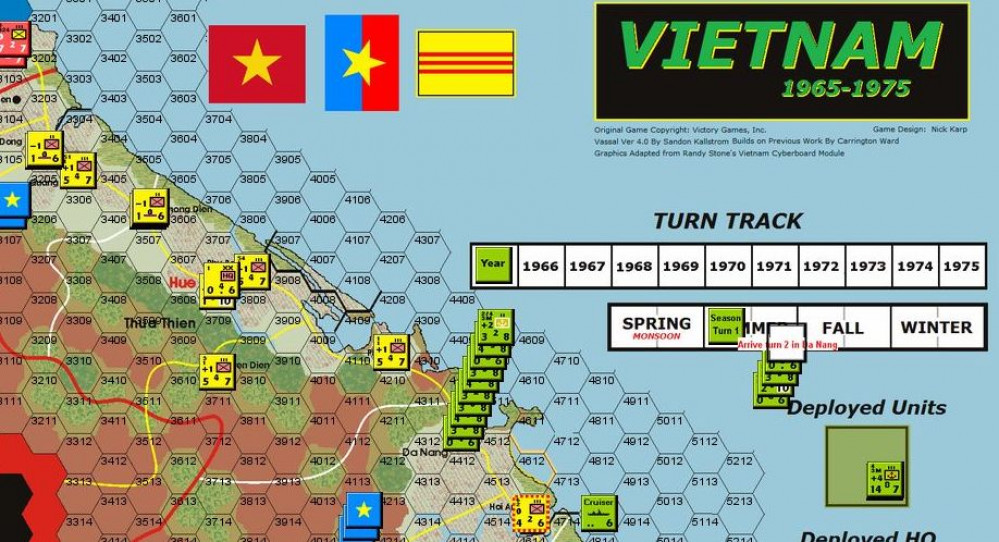
Vietnam 1965-75 Hex & Counter (Victory Games)
Battle for I Corps - Turn 1
Posting up a battle report from a game played some time ago now, so my memory may be a little foggy on this one. This was played over the excellent Vassal module for this game and part of the delay was waiting on some image files from my opponent playing the NLF (VC/NVN) side. The VC counters display hidden for the US player as they only know where the VC have presence, but not necessarily the strengths until that unit acts.
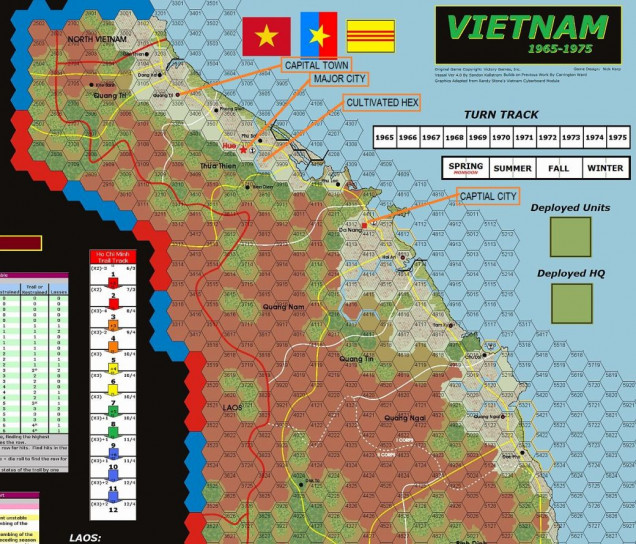 Quick note on scoring - typically, the NLF player receives victory points for each unit occupying city, capital and cultivated hexes at the end of a scenario. They also gain lots of points for entering a capital or major city during the scenario and eliminating US counters and a lesser amount of points for US Replacements expended to cover losses. The US player receives a smaller amount of points for VC units destroyed or dispersed or NVN counters destroyed or replacement points expended. The main focus for the US player in a scenario is not to lose control of the cities and population centers.
Quick note on scoring - typically, the NLF player receives victory points for each unit occupying city, capital and cultivated hexes at the end of a scenario. They also gain lots of points for entering a capital or major city during the scenario and eliminating US counters and a lesser amount of points for US Replacements expended to cover losses. The US player receives a smaller amount of points for VC units destroyed or dispersed or NVN counters destroyed or replacement points expended. The main focus for the US player in a scenario is not to lose control of the cities and population centers.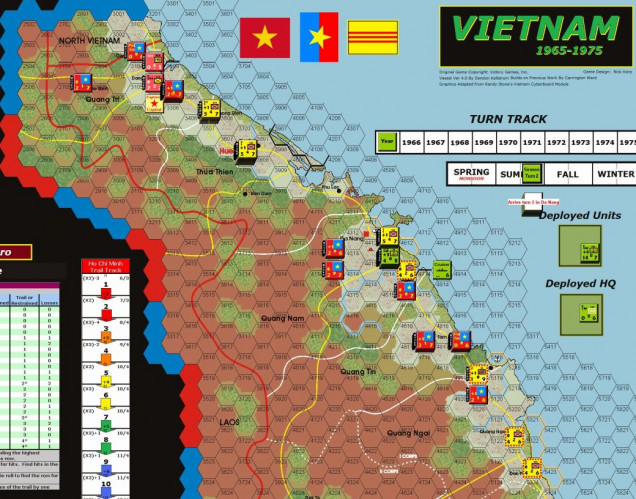 (NVN first actions shown) The Battle for I Corps scenario represents actions during the Tet offensive in the north of South Vietnam. 1st & 3rd Marine elements are present in dispersed deployments as is the 26th Marine in the consolidated deployment. Elements of the 101st, 23rd Division, 1st Cavalry and artillery support are also deployed. Battalion and regiments from the 1st and 2nd ARVN are available - the 2nd is 'ineffective' for the whole of the scenario (cannot conduct operations, essentially a garrison force). All US controlled forces start in pre-determined hexes. A Cruiser, respectable amount of Air Points and limited airmobile points are available to the US Player. The NVN player gets 2 VC regiments, 25 VC battalions and 6 Pol sections (dummy units) to deploy anywhere in the play area. The NVA 304th, 325th, & 320th divisions and some minor support can be deployed anywhere in NVN or Laos. The NLF player scores points for occupying even if expelled in this scenario, so it becomes a true rush for the population centers. Being an offensive (Tet), the NLF player scores a point for every attack made. Final scoring is (NLF score - US score). 65 or less is a US victory, 66-85 is a draw.
(NVN first actions shown) The Battle for I Corps scenario represents actions during the Tet offensive in the north of South Vietnam. 1st & 3rd Marine elements are present in dispersed deployments as is the 26th Marine in the consolidated deployment. Elements of the 101st, 23rd Division, 1st Cavalry and artillery support are also deployed. Battalion and regiments from the 1st and 2nd ARVN are available - the 2nd is 'ineffective' for the whole of the scenario (cannot conduct operations, essentially a garrison force). All US controlled forces start in pre-determined hexes. A Cruiser, respectable amount of Air Points and limited airmobile points are available to the US Player. The NVN player gets 2 VC regiments, 25 VC battalions and 6 Pol sections (dummy units) to deploy anywhere in the play area. The NVA 304th, 325th, & 320th divisions and some minor support can be deployed anywhere in NVN or Laos. The NLF player scores points for occupying even if expelled in this scenario, so it becomes a true rush for the population centers. Being an offensive (Tet), the NLF player scores a point for every attack made. Final scoring is (NLF score - US score). 65 or less is a US victory, 66-85 is a draw.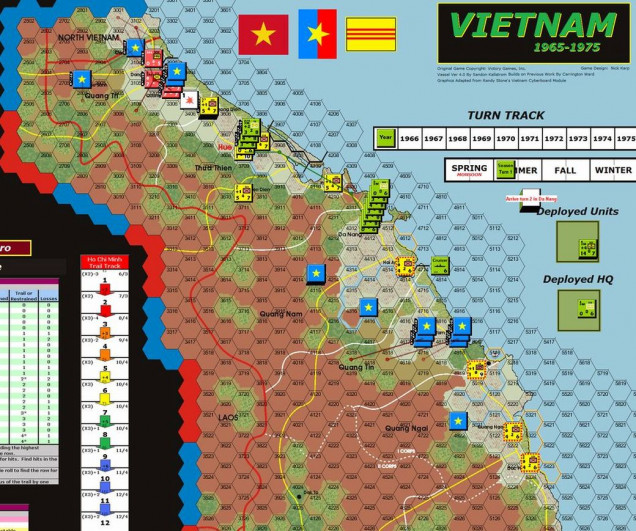 (US Player view) VC and NVN attacks in the north of the Corps pushed the ARVN forces out of Dong Ha and Quang Tri. 1st Marine elements moved from Da Nang to Hue. VC units in the south make some quick pushes in Quang Tri province to occupy towns and cultivated hexes. The NLF player controls the tempo of the game by usually having the option of deciding who gets to take the next action. In the campaign and other scenarios, they can benefit from being more passive and reacting to US movements. This scenario rewards attacks and quick gains and my opponent was being quite aggressive(!).
(US Player view) VC and NVN attacks in the north of the Corps pushed the ARVN forces out of Dong Ha and Quang Tri. 1st Marine elements moved from Da Nang to Hue. VC units in the south make some quick pushes in Quang Tri province to occupy towns and cultivated hexes. The NLF player controls the tempo of the game by usually having the option of deciding who gets to take the next action. In the campaign and other scenarios, they can benefit from being more passive and reacting to US movements. This scenario rewards attacks and quick gains and my opponent was being quite aggressive(!).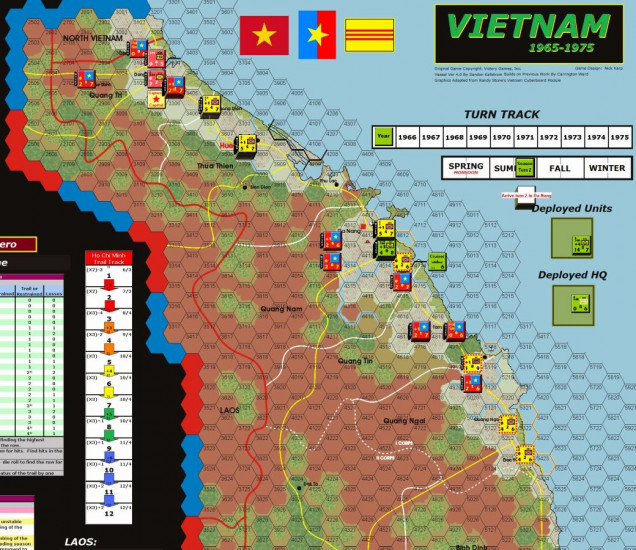 The first turn ended with some consolidating movements and preparation for operations in Turn 2. The US player receives reinforcements at the start of Turn 2 (3 1st Cav regiments and Div HQ). In hindsight, this is where I should have pushed more as the US Player. Worried about leaving critical hexes exposed, I fell into a reactive role and couldn't press to make gains.
The first turn ended with some consolidating movements and preparation for operations in Turn 2. The US player receives reinforcements at the start of Turn 2 (3 1st Cav regiments and Div HQ). In hindsight, this is where I should have pushed more as the US Player. Worried about leaving critical hexes exposed, I fell into a reactive role and couldn't press to make gains.
































![TerrainFest 2024! Build Terrain With OnTableTop & Win A £300 Prize [Extended!]](https://images.beastsofwar.com/2024/10/TerrainFEST-2024-Social-Media-Post-Square-225-127.jpg)








































Leave a Reply